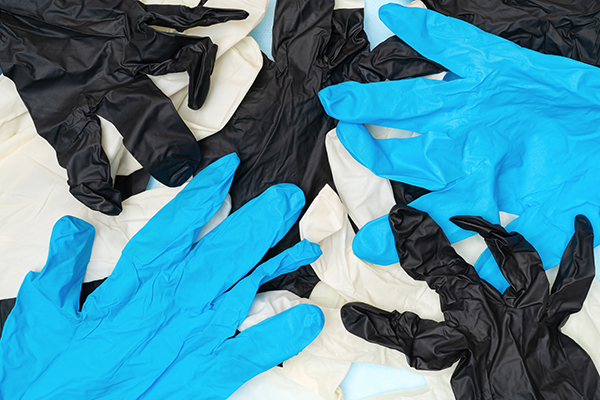To Toss or Not to Toss? That is the question.
Our first blog for the month emphasized the basic safe food practices needed to keep you and your guests healthy (and happy!), especially during these times of COVID. The impact of foodborne illness can range from an uncomfortable few days to hospitalization or death. Foodborne illness IS preventable and the steps taken to keep food safe also maintain quality of food, and ultimately profitability. Think of attention to food safety as part of quality control and a win-win business strategy. Knowledge about food safety can be helpful when controlling costs as making wise decisions when determining the fate of unserved food can affect the bottom line.
“When in doubt, throw it out”. You’ve likely all heard this old adage one too many times. This saying is commonly used in food safety training because it is easy to remember and allows for an excess of caution as a way to prevent risk of foodborne illness from contaminated food. But exercising judgement will avoid unnecessary food waste. Controlling when and how foods are prepared depends on accurate forecasting and when possible, a “just in time” or “cooking to the line” strategy.
With the exception of the fruitcake that has circled the globe, most foods are perishable. Many food processors include “best if used by” dates on their products. This is helpful for an unopened container. If there are leftover prepared foods, the general rule of thumb is that many may last up to seven days. Factors that cause deterioration of quality, and ultimately safety, relate to actions or conditions during the processing, storage, preparation, holding, service, or cooling of foods. There may be loss of quality as the product ages. Some foods it is advised to discard after four days. USDA FSIS has developed resources that you may find helpful. As an added bonus, this link has a page for food recalls. USDA also has a new app called FoodKeeper (search your App Store for ‘USDA Foodkeeper’), but there is also a web-based version available. With this, you simply browse for food item in question to assess safe storage time.
With the exception of the fruitcake that has circled the globe, most foods are perishable. Each food may have a different storage time, dependent upon past use, processing form, and characteristics of the food item.
The reason each food may have a different storage time is dependent upon past use, processing form, and characteristics of the food item. Highly acidic foods, such as salad dressings, and those processed as a shelf-stable product, such as jams and jellies, will maintain their safety and quality longer because bacteria do not grow well in environments with low pH (the foods are acidic) or lack of water activity (because of binding by sugar or salt). To control waste of food, follow these guidelines:
- Ensure storage conditions in the foodservice don’t lead to accelerated deterioration.
- Dry storage temperatures should be maintained between 50° to 70°F in locations with low humidity levels.
-
- Be certain the location is also secure from intentional contamination or theft.
-
- Refrigerated storage temperatures should be maintained between 32°F and 41°F.
- Recognize that temperatures will be warmer closer to the door.
- Use an internal and external thermometer to log temperatures.
- Rotate items as they enter inventory using First In, First Out (FIFO).
- Date containers of items as they are placed into storage – this helps with tracking inventory and in the event of a recall.
- Freezer storage temperatures should keep foods frozen solid, generally below 0°F.
- Dating of items, proper packaging, and rotation of stock avoids potential for freezer burn and other loss of quality.
- Dry storage temperatures should be maintained between 50° to 70°F in locations with low humidity levels.
- Purchase items to meet needs, balanced with delivery schedules and cost.
- At least once a week delivery for perishable items should be scheduled.
- Inspect products at receiving to check that proper quality and quantity of foods are delivered.
- Prepare foods as close to service as possible.
- Not all menu items can be done to order, but for those than can, implement this practice. It will likely control waste and improve quality!
- Monitor inventory levels of perishable foods.
- Work foods into service schedule or freeze for later use.
- There should be no “surprises” on the bottom shelf of the walk-in.
- Review popularity of menu items and purchase units.
- What are the “winners” and what are the “losers” on the menu?
- In terms of menu engineering, shoot for the “stars” – the high profitability and highly popular items.
- Incorporate the philosophy of “multiple functionality” into purchased ingredients, the same as you likely do for equipment.
Some of these tips depend on having good records to review. Don’t forget that good management involves documenting that good practices were followed. But don’t keep the paper just to say you did. Recognize documentation is more than a “Paper Chase” – records tell the story of what is working and what is not. In today’s challenging (and litigious) world, actions that will help lower risk should be taken. Risk Nothing!
PS: The food safety team at FoodHandler wishes you the very best holiday season. We, too, are ready to bring in the new year and cast 2020 aside!
READ MORE POSTS
Addressing Major Food Recalls in Your Business
It seems like every year we have a large-scale food recall that reminds consumers and foodservice operators about the importance of food safety. Not that we need reminded, but it certainly puts the topic in the headlines again. Last year, it was the onion recall. This year, it may very well be the Jiff peanut butter recall, of which we are in the midst of. At the time of the publishing, we are starting to learn more about a potential hepatitis A outbreak linked to strawberries. If you have not been impacted by either of these recalls in your personal or business life, I would be surprised.
Sanitation, Sanitation, Where Art Thou?
Continuing the theme I picked up on a few months ago, discussing common causes of foodborne illness, I’d like to focus this blog on cross contamination, more precisely sanitation. Sanitation is another issue that employees don’t often do at home, so they discount the importance of it in the food production environment. That is to say that they have never made someone sick at home because they only clean their countertops and they have likely never sanitized their kitchen, so why is it so important in a foodservice facility?
Handwashing: The Habit that Isn’t as Common as We May Think
Earlier this year, I started to focus our FoodHandler Food Safety blogs on common food safety issues faced in each foodservice operation across the world. We’ve covered some of the most common issues, but perhaps none is more common than improper hand hygiene.
Is Implementing a Color-Coded Food Safety Plan Right for your Operation?
Foodborne pathogens are by far the most prevalent cause of foodborne illness in the United States and across the world. There are 31 known agents that cause foodborne illnesses, and more that are unspecified or yet undiscovered – remember, E. Coli 0157:H7 wasn’t identified until the early-1980s. It is estimated each year, 48 million illnesses occur because of these known and unknown pathogens, resulting in over 3,000 deaths.










